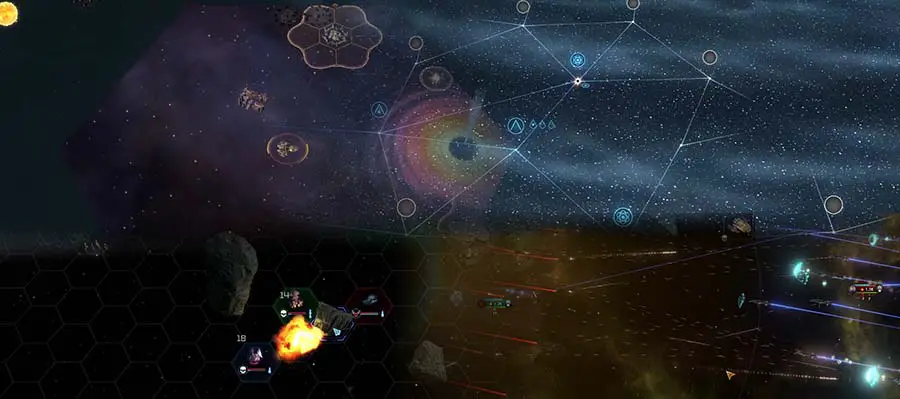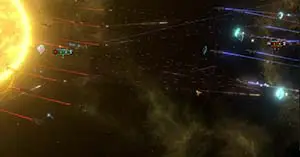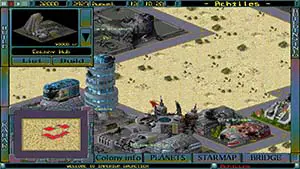
I love strategy games, both RTS and turn-based, but I especially love strategy games with outer space as the theme. There’s nothing better than building a stellar empire from scratch and dominating everyone in sight. Here is a completely subjective list of some of my favorites.
Stellaris

My current favorite, and in my opinion currently the best space strategy game, is Stellaris. Stellaris has amazing depth and so much variety that I never get tired of playing it. Although the Utopia DLC was great the Nemesis DLC has become my favorite addition to the game.
To sum Stellaris up, it’s a game where you start out with one planetary system and expand your empire, same basic premise as most space strategy games. Although the similarities to most space strategy games doesn’t end there the depth of the game is one of the areas where it shines. This game pulls the best from other games into it and is the most complete game I’ve ever played.
At the start you have one Science Ship for exploration, one Construction ship for building outposts, mining stations and research stations. On any planets you own you can construct districts and buildings which adds to your economic power. As you explore you can colonize more worlds and come into contact with alien species, some of which are not very friendly.
There are plenty of pre-made empires to start a game with plus you can customize one if you want one suited to your playstyle or want to build one for a specific strategy for a particular game.
Stellaris has a great economic system, diplomacy and espionage. With the DLCs (like the Relics DLC) you can assign a Science ship to excavate a site, which can give you a pretty good game perk and lots of minor artifacts, which can be used for special things like L-Gate insights.
In Stellaris you can set the ending year so you can “win” the game, but you can still play beyond that year if you’d like. With the Nemesis DLC you can now either become an End Game Crisis with the power to destroy the entire galaxy if left unchecked, or you can become the Galactic Custodian and defend it. You can even make yourself the emperor of the galaxy if you play your cards right.
There’s much more to the game that can’t be covered in one simple summary, but I have plenty of Stellaris articles on the site, like how to play the game or how to use Influence.
Imperium Galactica

Believe it or not this is still one of my favorite games although I don’t play it much anymore due to Stellaris. This was published in 1997 by GT Interactive and still works today although it plays in DosBox.
The graphics are primitive by today’s standards, but it has all the elements I look for in a space strategy game plus it has one feature that I consider all the other space strategy games lacking in and that’s detailed ground combat that proceeds graphically, just like a battle in space. Stellaris comes close but there’s just something about maneuvering your tanks into position during a planetary invasion that I find particularly gratifying in Galactic Imperium.
Believe it or not this is still one of my favorite games although I don’t play it much anymore due to Stellaris. This was published in 1997 by GT Interactive and still works today although it plays in DosBox. The graphics are primitive by today’s standard, but it has all the elements I look for in a space strategy game plus it has one feature that I consider all the other space strategy games lacking in and that’s detailed ground combat that proceeds graphically, just like a battle in space. Stellaris comes close but there’s just something about maneuvering your tanks into position during a planetary invasion that I find particularly gratifying in Imperium Galactica.
Similar to Stellaris, this one has colony and fleet management, exploration, and a lot of cutscenes (okay, Stellaris doesn’t have any of those). The colony management is so detailed that it not only lets you repair damaged buildings, but you can also watch them being repaired right before your very eyes if you want to. I still have to resist the urge to play it and conquer the Dargslans whenever I start a game just to take a look at it, for instance, when I write an article like this.
Imperium Galactica 2

Built upon the original Imperium Galactica, this is another favorite of mine. Imperium Galactica 2 was released in 1999 and gives you the option of playing one of three empires, the Solarian Empire, the Shinari (an excellent economic and diplomatic power) or the Kra’Hen, whose sole purpose is to dominate and enslave the galaxy.
The Kra’Hen have no options for diplomacy, making them a little easier to play. This is a real fun empire to play.
This game also added a 5-part tutorial to teach you how to play and scenarios. It also has the tank battles I love so much and space combat, economic management, and diplomacy for the Shinari and Solarian Empire.
I especially love playing the Kra’Hen simply because they are so evil and take delight in exterminating their enemies. They start out with one planet and try to remain hidden from the other empires until they are strong enough to take them on and defeat them.
This game has a bug or two that will sometimes stop you from completing a game, but I still have a lot of fun with it.
SINS of a Solar Empire: Rebellion
In between the Imperium Galactica games and Stellaris SINS of a Solar Empire: Rebellion was my “go to” space strategy game and is another one I still play from time to time. SINS has four DLCs that add maps and custom factions to the game and with the Rebellion version you can play one of six empires, each starting with a single planet.
This game has a tutorial that teaches things like game basics, how to use the interface and how to set up a good defense. This game uses phase lanes so you can’t move freely from one planet to the next but need to follow a specific route. Some players don’t like them, but it does give a defensive player the ability to set up strong defensive positions.
It lacks any detailed ground combat, all you need to do is bombard a planet into submission from space, but other than that it is a really good game. This game has fast paced action with you running into pirates and other empires almost immediately. You can form alliances and fight battles together only to see them disintegrate once the immediate threat is over.
Game set up for SINS is pretty simple and it really has only a few options, but those options are pretty deep. At the start of the game, you can select a small, medium or large map and there are over 30 maps in each category, even without any DLCs, each with its own specific challenges.
There are six additional victory options you can set in case conquering the entire galaxy isn’t your thing, like having a victory when you capture all the enemy empire’s capitals or a research victory, but I usually play with those off.
The last step before the game actually starts is selecting your race or letting the game do it for you. Depending on the map size and type of map you will get up to a dozen AI opponents, which you can also select or allow the game to randomly select them for you.
Once started you send Scout ships out to explore any nearby planets and encounter pirate fleets guarding those planets or asteroids right away. The only way to claim these is first by exterminating the pirates with your own fleets and then colonizing the planets or asteroids with a colony ship.
The ability to conquer the galaxy and its immediate action (combat) are what draws me into the game and are the things I like the most about it. I’ve spent many, many hours playing SINs of a Solar Empire: Rebellion.
Galactic Civilizations 3
For a while Stellaris and Gal Civ 3 were where I spent all my game time. Galactic Civilizations 3 has a tutorial and lots of game customizations. It has a Civilization builder that will let you customize your race and empire, right down to traits and personalities. I’ve dumped a lot of playtime into this game as well.
One of the weaknesses of this game at first was how it handled the campaigns, which are mostly DLCs. Due to the way they were laid out and released you really couldn’t play them chronologically. For example, the tutorial is actually one of the last campaigns chronologically in the game. Stardock revamped the layout so that is no longer a problem, just in case you’re interested in playing the game that way.
During game set up you can set the galaxy size and shape, set victory conditions and choose who your nasty neighbors will be. Just like the other space games I enjoy so much this one has colony management, fleets of ships, plenty of nasty, and a few friendly neighbors, and lots of space to explore and exploit.
One of the big differences between this game and others is that it is turn-based rather than RTS. At first, I thought I wouldn’t like that, but it really made it a good game experience. This game has artifacts you can recover as you explore space that will do things like add money to your treasury, terrific starbases you can build, espionage, a marketplace and ideology.
The colony management options are pretty detailed plus you can upgrade buildings as those options become available, usually through research. Unlike Stellaris this game has detailed maps you can manage your planets with and choices about where to place buildings for optimal output.
One of the unique things about this game is the use of ideologies and it’s worth mentioning. During the game you accumulate Ideology points and when you have enough you can choose bonuses from one of three branches, Benevolent, Pragmatic and Malevolent. Each branch has four paths you can take and although you can switch paths, or even Ideologies, you can’t unlock a bonus until the one before it is unlocked. Bonuses include a free, fully loaded colony ship, 3 free constructor ships, you can make anyone unpopular with the community if they go to war with you or get a free warship. And that’s only a few of 20 options for each ideology.
Crying Suns
In Crying Suns you take charge of a battleship and try to figure out what happened to the galactic empire you once helped run and restore it to its former glory if possible. You start out at a cloning factory where a clone of Admiral Idaho is created and Kaliban, the OMNI guardian of the facility, briefs you about what he knows about the apparent collapse of the empire, which isn’t much.
It’s a lot of fun with plenty of combat and mystery and if you get killed no problem, the OMNI guardian just creates another clone of the admiral.
The things that make this game so appealing to me is the mysterious storyline and the anomaly encounters. You really have no idea what’s going to pop up next or whether exploring that latest anomaly you’ve discovered will help you or kill you.
Distant Worlds Universe
I haven’t played this game in a long time but what piqued my interest in it once again is the fact that Distant Worlds 2 is due to be released soon. It’s been so long since I played this game so I had to refresh my memory by going through the tutorials. Distant Worlds Universe is definitely not a game you can just jump right into without taking the tutorial, even if it’s the introductory game. If you do, you’ll be confronted with a bunch of ships and other stuff orbiting a planet without a clue about what to do.
Don’t forget to visit my YouTube channel at https://www.youtube.com/channel/UCcWU6qxVisK93h5guKRVtdg
This is a game that rivals any of the others when it comes to depth and playability. This is another game where building up your empire from a single colony is a joy. Almost everything can be left on automation until you’re familiar with the game and want to take over tasks when you feel like it, like conducting research. The galaxy is vast and awesome with plenty of alerts and decisions to keep you focused and interested.

